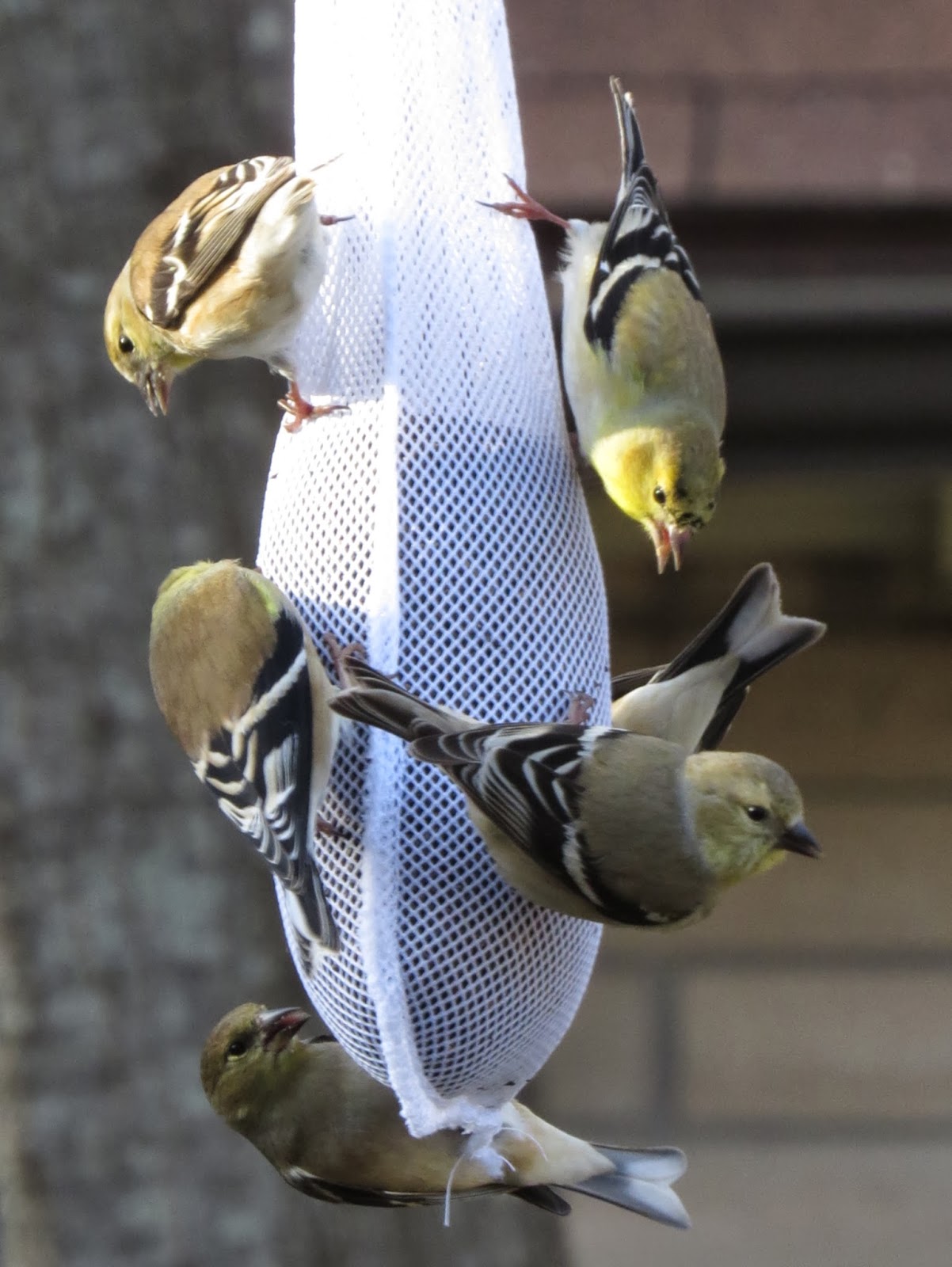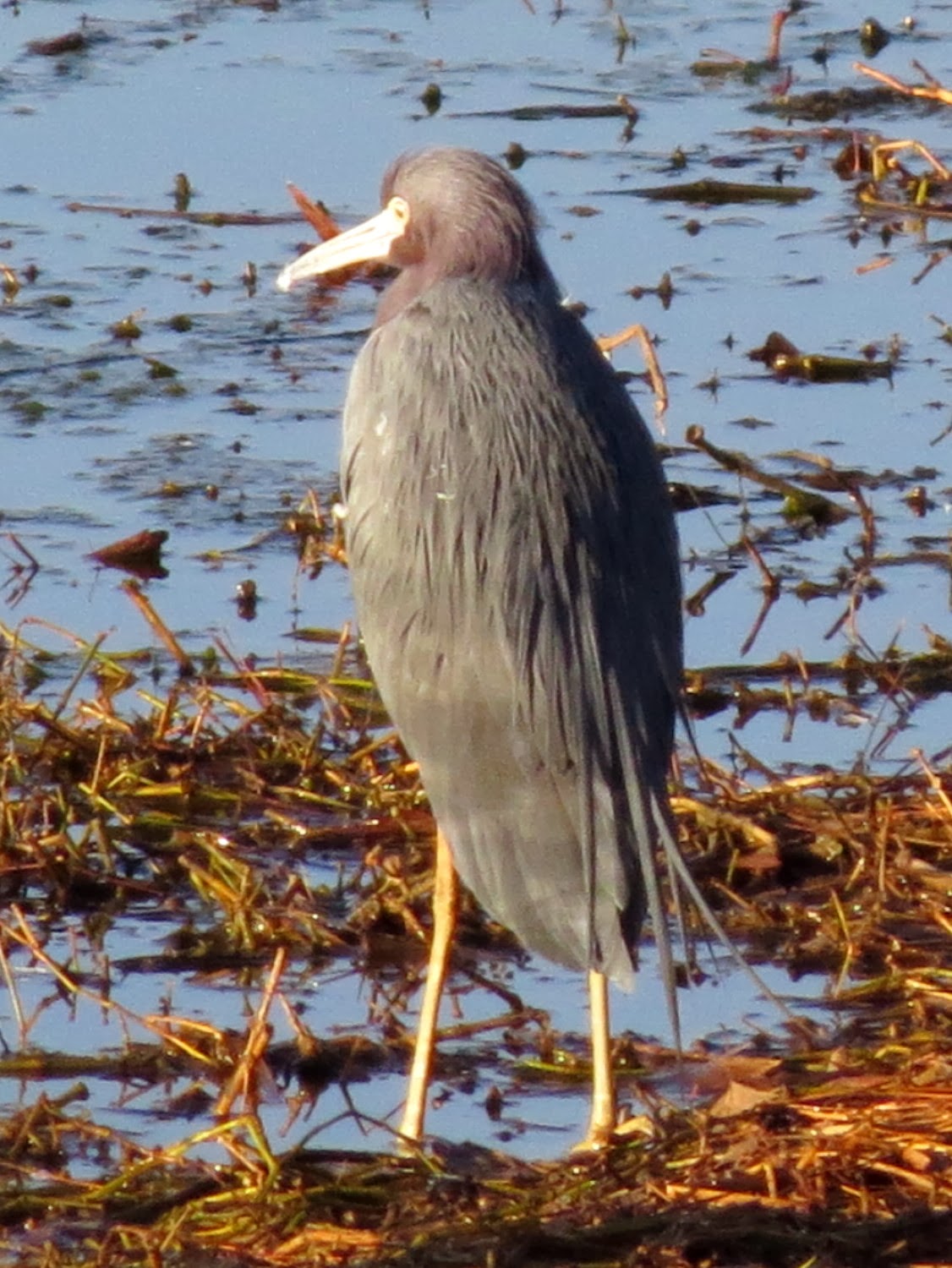.
Our Yards
Some friends gave us a glass, Art Deco birdfeeder for Christmas. The birds like it and some of them - like this White-winged Dove - look very striking indeed when they perch on it.
Our one-legged male Northern Cardinal isn't letting his disability limit his activities. He visits our feeders constantly and now often turns up accompanied by a female Cardinal.
Eastern Bluebirds are birds of fields and open woodland. However, several hang out in our subdivision and visit our feeders.
Watching Hawks
Different raptors react very differently to being watched. For example, I find that Red-tailed Hawks and American Kestrels are particularly skittish; they usually fly off as soon as you stop your car anywhere near them. Red-shouldered Hawks, on the other hand, are much more tolerant of human observers. This seems to be the case with Cooper's Hawks also. The one below gave me a quick look when I parked a few feet away and rolled down my window, but then proceeded to ignore me and my camera.
Near CyFair College
The retention ponds at the college have hosted very few wildfowl or gulls in the past couple of winters, and they have never attracted pelicans. However, I don't have to go far to see these kinds of birds. Just across Barker Cypress Road from the college there is a park with a large lake that is usually busy with American Coots, various ducks, American White Pelicans and Ring-billed Gulls.
.
.
It has been unusually cold here for the past few days. Well, unusually cold for the Houston area anyway.
The cold has meant that our feeders have been busier than ever. As my college closed for two days because of the weather, I've been able to spend quite a lot of time watching our visitors.
Thirty or so American Goldfinches have been arguing endlessly and very aggressively over our one thistle seed feeder.
The Goldfinches that haven't managed to get to the thistle seeds have flocked to our other feeders and to seed I have been sprinkling on the ground, on our fence, and on the tree stump that supports one of our birdbaths. They've been visiting our birdbaths also, whenever I've put hot water in them to thaw them out.
We've had flocks of 20+ Chipping Sparrows, too. I never tire of watching these lovely little birds. They always look so neat and tidy.
Our suet feeders have been very much in demand. So much so that our Downy Woodpeckers have gotten quite used to sharing them with a Ruby-crowned Kinglet, Orange-crowned Warblers and Pine Warblers.
Speaking of Pine Warblers, we seem to have more of these than in previous years. I'm not sure how many are visiting but it must be at least five or six.
Our male Ruby-crowned Kinglet remains a constant visitor.
Several Orange-crowned Warblers visit all day every day as well.
Last January a group of four Brown-headed Nuthatches took up residence in our yards for the first time and stayed with us until the summer. This year only one has appeared and it has been making only a few very brief visits every day. Yesterday it stayed on a suet feeder longer than normal, which enabled me to grab a quick photo.
I'm hoping it will soon feel secure enough to stay longer on our feeders and that some other Nuthatches may show up to join it.
.
Last Saturday we arranged to meet friends for a walk and a picnic lunch at Baytown Nature Center, which is an hour's drive southeast of where we live.
One of the reasons for choosing Baytown was to see the Great Horned Owl that is currently nesting there. It was just visible in the trees along the entrance road.
The first section of the bay was empty of birds except for sone distant Cormorants but the pond opposite had a range of shorebirds: Lesser Yellowlegs (below), Killdeer, Wilson's Snipe, Least Sandpipers and Spotted Sandpiper (below).
The same birds turned up at the other ponds we visited, along with the usual Great Blue Herons, Great Egrets and Snowy Egrets (below).
I scanned every patch of water for the Hooded Mergansers and Common Goldeneyes hat had been reported at the site but I came up empty.
Sparrows were surprisingly scarce. The only ones I saw were a single Swamp Sparrow and a small group of Savannah Sparrows (below).
The butterfly garden had a pair of Eastern Bluebirds, as well as a small group of Brown-headed Cowbirds.
I wasn't able to get any clear shots of an Osprey that we saw fishing several times but a female Belted Kingfisher posed for photos as we were leaving.
.
.
Last year I discovered a new birding site less than a mile from where I live: the Longwood Retention Pond. It isn't the greatest site, consisting as it does of just a large artificial pond surrounded on one side by some largely inaccessible woodland. However, I like to take a walk around the pond every couple of weeks because, like almost any patch of water in our area, it often has several wading and water birds. Another reason for visiting this site is that a pair of Bald Eagles has a nest in the trees - and who can resist watching Bald Eagles!
On Saturday morning my walk started with good views of a Loggerhead Shrike, a bird that I can never resist taking pictures of.
The utility wires were hosting White-winged Doves and Red-winged Blackbirds, as well as an American Kestrel (below).
A Snowy Egret was doing its morning preening at the water's edge.
One of the birds I was hoping to see was a Little Blue Heron which regularly hangs out at the pond. Sure enough, the bird soon joined the Snowy.
A Great Egret flew in, too, its plumage spectacular in the morning light.
I find it interesting how Snowy Egrets often hang out next to Great Egrets and/or Little Blue Herons. I suppose the reason is that the species don't hunt in the same way and therefore don't directly compete for food. Great Egrets and Little Blue Herons move stealthily and slowly, sneaking up on their prey. By contrast, Snowy Egrets tend to rush around in the water, stirring up prey with their bright yellow feet.
The open area of the pond was quiet except for a couple of Pied-billed Grebes and Double-crested Cormorants. The edges had a dozen or so Killdeer and Least Sandpipers. While I was watching a Yellowlegs, I noticed a Wilson's Snipe wandering nearby.
On my previous visit the female Bald Eagle was sitting on the nest. This time she was on the nest again - but hardly visible - while her partner was perched nearby.
By the way, if you're thinking that the photo of the nest isn't very good, I agree. However, it's because it was taken from far away, in order to avoid disturbing the nesting birds. (Bald Eagles will abandon their nests if people approach them too closely.) Here's a picture showing the scene from where I was standing when I zoomed in on the nest.
The trees and bushes around the pond had a selection of common birds: Red-shouldered Hawk, Orange-crowned Warbler, House Wren, Swamp Sparrow, Yellow-rumped Warblers and Ruby-crowned Kinglets. Just as I was leaving, I noticed my final bird, an Eastern Phoebe which was fly-catching from the top of a small snag.
.
.
In my last post I focused on the winter residents in our yards. While doing so, I forgot to mention one visiting species: Chipping Sparrow.
Every winter we often have up to a dozen of these cute little sparrows in our yards. Surprisingly, they frequently turn up at the same time as the much larger House Sparrows.
The two or three Tufted Titmice that appeared last year seem to have become permanent residents - and very welcome they are, too.
Our one-footed male Northern Cardinal continues to thrive. He's one of half-a-dozen Cardinals that regularly visit our feeders.
Other permanent residents include White-winged Doves, Carolina Wrens, Carolina Chickadees, Northern Mockingbirds (below), a pair of Downy Woodpeckers (male below) and a female Red-bellied Woodpecker.
Dee and I were excited when a pair of Eastern Bluebirds checked out our only birdhouse at Christmas.
Unfortunately, the Bluebirds must have decided the accommodation was sub-standard because they have never returned.
.

















































